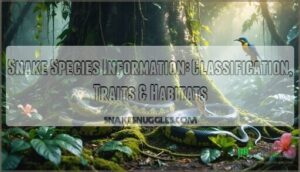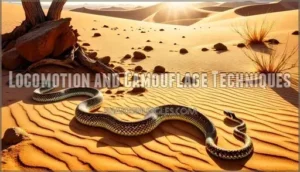This site is supported by our readers. We may earn a commission, at no cost to you, if you purchase through links.
 Most people picture snakes as uniform, scale-covered predators, yet over 3,000 recognized species exhibit stunning variations in anatomy, venom chemistry, and ecological roles. Your understanding of snake species information begins with their placement in Kingdom Animalia, progressing through Phylum Chordata and Class Reptilia to the remarkably diverse Order Squamata.
Most people picture snakes as uniform, scale-covered predators, yet over 3,000 recognized species exhibit stunning variations in anatomy, venom chemistry, and ecological roles. Your understanding of snake species information begins with their placement in Kingdom Animalia, progressing through Phylum Chordata and Class Reptilia to the remarkably diverse Order Squamata.
These limbless vertebrates occupy every continent except Antarctica, adapting to deserts, rainforests, oceans, and even urban environments through specialized physical traits you’ll find nowhere else in the animal kingdom.
From the microscopic Thread Snake measuring just four inches to the reticulated python stretching beyond twenty feet, snakes demonstrate evolutionary innovation that challenges conventional assumptions about what defines successful predation, survival, and reproduction.
Table Of Contents
- Key Takeaways
- Snake Classification and Evolution
- Physical Traits and Adaptations
- Habitats and Geographic Distribution
- Diet, Behavior, and Venom
- Conservation Status and Human Impact
- Frequently Asked Questions (FAQs)
- Which snake is the silent killer?
- How do snakes move?
- Do snakes have ears?
- How fast do snakes grow?
- What is molting in snakes?
- What physical trait sets snakes apart from other reptiles?
- What are 5 interesting facts about snakes?
- What is the top 1 snake?
- How many species of snakes are there?
- What is the rarest snake?
- Conclusion
Key Takeaways
- Snakes comprise over 3,000 species distributed across every continent except Antarctica, organized into 15+ families within Order Squamata, with evolutionary origins traced to Middle Jurassic terrestrial lizards approximately 167 million years ago through progressive limb reduction and axial elongation.
- These limbless vertebrates exhibit remarkable anatomical specialization, including 200-400 vertebrae enabling flexible locomotion, elongated internal organs arranged linearly, and distinct scale types—dorsal scales providing camouflage while ventral scales generate traction—with sizes ranging from 10-centimeter threadsnakes to 10-meter reticulated pythons.
- Fewer than 300 snake species possess venom, and only half can deliver lethal bites to humans, with most relying instead on constriction or whole-prey consumption, while their predatory strategies and venom delivery mechanisms (neurotoxic, hemotoxic, or cytotoxic) reflect millions of years of evolutionary refinement tailored to specific prey selection.
- Snake populations face critical conservation challenges from habitat loss, climate change, and human persecution, with approximately 100 species now endangered despite their ecological importance as ecosystem architects, while the international snake trade generates billions annually and snakebite treatment costs ASEAN nations alone 2.5 billion USD per year.
Snake Classification and Evolution
Understanding where snakes fit in the tree of life helps you appreciate their extraordinary journey from ancient lizards to the diverse predators we see today.
You’ll trace their lineage through formal taxonomic ranks, explore the major family groups that organize thousands of species, and examine the fossil record that reveals their evolutionary origins.
Let’s start with the fundamental building blocks of snake classification.
Kingdom, Phylum, Class, and Order
You’ll find snakes nested within a hierarchical taxonomic framework that begins at the kingdom Animalia and extends through the phylum Chordata, the class Reptilia, and finally the order Squamata—a classification that places them alongside lizards and amphisbaenians as scaled reptiles distinguished by their kinetic skulls and specialized integumentary structures. This Taxonomic Hierarchy reflects evolutionary relationships, with Serpentes representing the formal suborder designation for all true snakes. Understanding Snake Classification helps you appreciate their vertebrate origins and Reptilia Traits:
- Kingdom Animalia encompasses all multicellular organisms with heterotrophic nutrition
- Phylum Chordata Characteristics include notochords and dorsal nerve cords
- Class Reptilia defines ectothermic amniotes with keratinized scales
- Order Squamata Features kinetic skulls enabling flexible jaw articulation
- Suborder Serpentes contains over 3,000 recognized species worldwide
Major Snake Families
Within the order Squamata, you’ll encounter over 15 distinct families that organize the world’s 3,000-plus snake species into taxonomic groups defined by skeletal morphology, scale arrangement, and venom delivery systems—with Colubridae alone accounting for roughly 39% of all documented serpent populations. These families reflect Snake Evolution and Biology through specialized adaptations, revealing Snake Species Diversity across distinct lineages.
| Family | Key Characteristics | Representative Traits |
|---|---|---|
| Colubridae | Diverse morphology, rear or absent fangs | Colubridae Traits include adaptable feeding strategies |
| Viperidae | Hinged solenoglyphous fangs, heat-sensing pits | Viperidae Fangs deliver hemotoxic venom efficiently |
| Elapidae | Fixed proteroglyphous fangs, potent neurotoxins | Elapidae Neurotoxins affect nervous system function rapidly |
You’ll recognize Boidae Size in constrictors exceeding 4 meters, while Pythonidae Heat-sensing labial pits enable precise prey detection—essential tools for Snake species identification and understanding Snake Classification frameworks.
Fossil Evidence and Ancestral Origins
Fossil records from the Middle Jurassic Era—174.1 to 163.5 million years ago—pinpoint when terrestrial lizards gave rise to the first ancient snakes, with Eophis underwoodi from southern England standing as the oldest known specimen at 167 million years.
This evolutionary history reveals snake origins through progressive limb reduction and axial elongation, foundational shifts in vertebrate anatomy that herpetology uses to trace snake evolution and biology across deep time.
The discovery of ancient snakes provides insights into snake evolution history and their adaptive radiation.
Physical Traits and Adaptations
When you look at a snake, you’re seeing millions of years of evolution crafted into a body built for stealth, efficiency, and survival. From their flexible skulls to their specialized scales, every physical feature fulfills a purpose in their predatory lifestyle.
Let’s explore the key anatomical traits and adaptations that make snakes such extraordinary reptiles.
Limbless Anatomy and Internal Structure
You won’t find legs or eyelids when you examine a snake’s anatomy, but you’ll discover a body engineered for efficiency through evolutionary reduction rather than simple loss. Their skeletal system contains 200–400 vertebrae, enabling remarkable body flexibility you’ll recognize as their signature sinuous movement.
Internal adaptations in snake physical characteristics include:
- Elongated visceral organs arranged linearly to fit their narrow body cavity
- Absent urinary bladder streamlining their reptile biology
- Specialized muscular structure coordinating with vertebrate anatomy for locomotion
- Modified scale morphology reflecting internal snake characteristics externally
Scale Types and Functions
Snakes possess two distinct scale categories with specialized mechanical properties and functional roles rooted in scale development. Dorsal and lateral scales form through self-organized pattern formation, creating hexagonal arrangements that aid camouflage across diverse snake habitats. Ventral scales develop differently, aligning with underlying ribs and muscles to heighten traction during locomotion.
This scale morphology reflects fundamental aspects of reptile biology—elastic modulus measurements reveal ventral surfaces withstand greater mechanical stress than dorsal regions. Understanding these snake characteristics helps you recognize how different snake species have adapted their protective armor to specific environmental demands.
Infants show caution when interacting with objects featuring python scale patterns.
Size, Weight, and Color Variation
From diminutive threadsnakes measuring just 10 centimeters to colossal reticulated pythons exceeding 10 meters, snake dimensions span an impressive spectrum—with body mass ranging from less than a gram in the smallest species to well over 200 kilograms in the largest constrictors.
Sexual dimorphism manifests prominently across snake species, where females usually outsize males in most taxa.
Regional variation produces distinct color morphs within individual species—snake characteristics that improve camouflage within specific snake habitats while revealing adaptive responses to local environmental pressures.
Locomotion and Camouflage Techniques
Without limbs to propel them forward, snakes have mastered an astonishing array of movement strategies—from undulating lateral waves across open ground to sidewinding through loose sand—while simultaneously deploying intricate color patterns and behavioral postures that render them nearly invisible within their respective microhabitats.
Body flexion combined with specialized ventral scales facilitates terrain navigation across surfaces ranging from smooth rock to dense vegetation, with arboreal snakes exhibiting striking gripping adaptations. Sidewinding motion allows desert species to traverse unstable substrates while minimizing heat exposure, exemplifying snake behavior refined through millennia. Adaptive color and snake camo patterns—from disruptive banding to cryptic stippling—transform these predators into ghosts within their environments, demonstrating how snake adaptations and camouflage work in concert.
- Rectilinear crawling propels heavy-bodied constrictors forward through synchronized muscle contractions without lateral undulation
- Concertina locomotion facilitates snakes to navigate narrow crevices by anchoring body sections while extending others forward
- Cryptic stillness paired with disruptive coloration renders even large specimens undetectable against matching substrate textures
Habitats and Geographic Distribution
Snakes have claimed nearly every corner of the planet, from sun-scorched deserts to dense rainforests and even the open ocean. You’ll find these adaptable reptiles thriving in environments that range from ground-level burrows to treetop canopies, each species fine-tuned to its particular niche.
Let’s explore where snakes make their homes and how they’ve spread across the globe.
Global Range and Continental Presence
Spanning every major landmass except Antarctica, snakes demonstrate impressive continental distribution across diverse biogeographic zones. You’ll find over 4,200 species distributed unevenly worldwide, with tropical regions harboring the greatest regional diversity due to favorable climatic conditions and reduced habitat fragmentation.
Geographic isolation on islands has driven unique species migration patterns and evolutionary trajectories, while snake geography reflects both historical dispersal routes and contemporary environmental barriers that shape global range limits and population structure across snake habitats today.
Terrestrial, Aquatic, and Arboreal Environments
You won’t encounter snakes confined to just one lifestyle—they’ve adapted to master terrestrial, aquatic, and arboreal environments with striking ecological flexibility.
Consider how snake habitats and geography vary:
- Ground-dwelling species navigate desert habitats and mountain terrain using specialized ventral scales
- Aquatic snakes possess valvular nostrils for wetland environments and coastal regions
- Arboreal specialists exhibit prehensile tails for forest ecosystems
This habitat diversification reflects millions of years of adaptive radiation across snake geographic distribution patterns.
Tropical Region Dominance
If you’re wondering where snakes truly thrive, the numbers tell a compelling story—tropical regions harbor the highest species diversity and biomass concentrations across all ophidian taxa.
Rainforest ecology provides year-round thermal stability and prey abundance that support over 70% of venomous snakes worldwide. This tropical biodiversity reflects ideal conditions for reptile diversity, where consistent climate resilience eliminates the physiological constraints that limit snake geographic distribution in temperate zones.
Native Vs. Introduced Species
While native snakes have occupied their current ranges for millennia through natural dispersal and evolutionary adaptation, introduced populations—whether through intentional release or accidental transport—now complicate biogeographic assessments across multiple continents.
You’ll find invasive species like Burmese pythons disrupting Florida’s native range boundaries, demonstrating how species invasion generates profound ecological impact on habitat diversity.
Conservation efforts now prioritize monitoring introduced species while protecting native species through targeted species adaptation research and restoration programs.
Diet, Behavior, and Venom
Snakes have evolved exceptional feeding strategies that reflect their role as specialized predators across diverse ecosystems. Understanding how they hunt, whether they rely on venom, and how they reproduce gives you insight into their behavior and survival tactics.
Let’s explore the key aspects of snake diet, venom mechanics, and life cycles.
Predatory Strategies and Feeding Habits
Every snake you’ll encounter operates as a specialized predator, relying on an arsenal of hunting techniques refined over millions of years to capture and consume prey that often seems impossibly large for their slender frames. These carnivores employ diverse ambush strategies—from constriction to venom efficiency—tailoring their predatory approach to specific prey selection.
You’ll find some species patiently waiting in camouflage while others actively pursue their meals, each demonstrating remarkably intricate feeding behavior that maximizes energy return.
Venomous Vs. Nonvenomous Species
Among the thousands of snake species you’ll encounter, fewer than 300 possess venom, and only half of those can deliver a lethal bite to humans. Most snakes rely on constriction or swallowing prey whole rather than toxin injection. Recognizing venomous snake species through pattern, head shape, and behavior helps you distinguish genuine threats from harmless species that share similar habitats.
- Venom types vary dramatically—neurotoxic, hemotoxic, or cytotoxic—each producing distinct bite symptoms
- Species identification requires observing pupil shape, scale arrangement, and defensive posturing beyond superficial color patterns
- Venom resistance in certain prey animals demonstrates evolutionary arms races between predators and their targets
Venom Delivery Mechanisms and Toxicity
Understanding how venomous snakes inject their toxins reveals the intricate weaponry evolution has refined over millions of years. Fang structure varies dramatically—some species deploy hollow, syringe-like fangs that fold against the palate until striking, while others possess fixed grooved fangs channeling venom into tissue.
Snake venom delivery systems exhibit striking precision, with toxicity levels calibrated through millions of generations. Antivenom development depends on understanding these delivery systems and the specific enzymatic cocktails each species produces.
Reproduction, Lifespan, and Mating Behavior
Reproductive strategies in snakes span a remarkable spectrum—from species that lay leathery eggs in carefully guarded nests to those that give birth to fully formed live young after months of gestation. During mating season, you’ll observe elaborate mating rituals involving pheromone trails and competitive combat between males.
Reproductive cycles align with environmental cues, triggering breeding habits that enhance offspring survival. Snake longevity varies dramatically—some species live merely five years while others exceed three decades in protected habitats.
Conservation Status and Human Impact
Snake populations face mounting pressures from habitat destruction, climate change, and human persecution, yet their ecological importance often goes unrecognized.
Understanding the conservation challenges these reptiles encounter—and the global efforts to protect them—reveals a complex intersection of biodiversity, economics, and public perception.
Let’s examine the key factors affecting snake survival and the strategies being implemented to secure their future.
Threats to Snake Populations
Snake populations face mounting pressures from multiple angles. Habitat Loss stands as the primary threat, driven by agricultural expansion and urban development. Climate Change alters thermal environments critical to reptile physiology. Human persecution persists due to fear and misunderstanding. Invasive species disrupt native ecosystems, while disease outbreaks spread through fragmented populations.
Conservation efforts for snakes remain underfunded despite their ecological significance. Approximately 100 species are now endangered—wildlife conservation initiatives must address these threats to snake populations comprehensively to guarantee reptile conservation and threats are properly managed, stabilizing snake conservation status globally.
Endangered Species and Legal Protections
Legal frameworks protect vulnerable snake species through international and national mechanisms. Around 100 snake species are currently classified as endangered on IUCN and CITES lists, necessitating stringent conservation laws and wildlife protection measures.
Habitat preservation and species monitoring form the backbone of reptile conservation and threat mitigation. Wildlife conservation initiatives track snake conservation status through systematic population assessments, enabling targeted interventions where endangered species face critical decline.
Snake Trade and Economic Impact
The international snake trade generates billions in revenue annually, with ASEAN nations alone shouldering approximately 2.5 billion USD in snakebite-related economic burden—equivalent to 0.09% of the region’s GDP. Direct medical costs from snakebite treatment account for roughly 69 million USD yearly, while wildlife trafficking and the pet industry drive collection of hundreds of thousands of live snake species.
Snake farming attempts to mitigate wild population depletion, yet conservation funding struggles to address threats from habitat loss and commercial exploitation affecting reptile conservation status across diverse wildlife ecology systems.
Conservation Efforts and Public Education
Protecting serpent biodiversity requires you to challenge centuries of fear-driven myths with evidence-based understanding of their ecological roles. Environmental policy reforms addressing reptile conservation threats strengthen wildlife conservation outcomes, while targeted snake conservation status assessments guide reptile research and study priorities for conservation action.
Habitat preservation and wildlife education programs empower you to support snake research through community outreach initiatives.
Frequently Asked Questions (FAQs)
Which snake is the silent killer?
Russell’s viper earns this grim title among deadly snakes—you won’t hear it coming. Unlike rattlesnakes that warn with their signature sound, this silent predator strikes without rattling or hissing.
It delivers potent venom through specialized pit viper fangs before you even realize danger’s near.
How do snakes move?
How does a creature without limbs navigate its world so gracefully? You’ll witness snakes employing impressive locomotion techniques through coordinated muscle structure and scaled friction.
Their slithering mechanism involves weaving lateral undulations across surfaces, demonstrating intricate reptile behavior honed through evolutionary ecology.
Do snakes have ears?
No, you won’t find external ear openings on snakes—these reptiles lack them entirely. Instead, their inner ear structure detects vibrations through jawbones, allowing sound detection without traditional auditory system components visible in most animals.
How fast do snakes grow?
Growth rates in reptiles depend heavily on Growth Rate Factors like prey availability and temperature. Your snake’s development accelerates with consistent feeding—species diversity means molting frequency varies, but Environmental Influences and Age Size Correlation determine Maturation Speed across different snake growth patterns.
What is molting in snakes?
You’ll witness your snake go through ecdysis—the molting process where it sheds its entire outer skin layer.
This skin shedding allows for snake growth and scale renewal, happening periodically throughout reptiles’ lives as they expand in size.
What physical trait sets snakes apart from other reptiles?
Unlike lizards with legs and movable eyelids, you’ll find snakes defined by their limbless condition and dramatically elongated body—a sleek design perfected through skeletal adaptations that distinguish these reptiles from all others.
What are 5 interesting facts about snakes?
Snakes possess striking adaptations you mightn’t expect. Over 4,200 snake species exist worldwide, displaying impressive characteristics like unhinging jaws to swallow prey whole.
Most venomous snakes control venom delivery precisely, and snake camouflage techniques rival any predator’s stealth.
What is the top 1 snake?
Determining one "top" snake depends on your criteria—venom research often highlights the inland taipan for its potency, while habitat analysis might favor the adaptable corn snake’s range and behavior across diverse ecosystems.
How many species of snakes are there?
You’ll find over 4,200 cataloged snake species worldwide as of August 2024, representing impressive reptile diversity and classification across global distribution.
This snake diversity spans 18 families, with types of snakes ranging from harmless colubrids to venomous species requiring ongoing venom research and conservation status monitoring for proper snake species identification.
What is the rarest snake?
The Saint Lucia racer holds the title as the rarest snake, with critically low population numbers. Habitat loss and introduced predators have driven this endangered species toward snake extinction, underscoring why conservation efforts remain essential for rare species survival.
Conclusion
Your journey through snake species information reveals a landscape where evolutionary innovation meets ecological necessity. Just as ancient mariners once charted unknown territories by recognizing patterns in stars, you can now navigate serpentine diversity through taxonomic markers, venom chemistry, and habitat preferences that distinguish one species from thousands of others.
These limbless vertebrates don’t simply survive—they architect ecosystems from rainforest canopies to desert sands, reminding us that adaptation isn’t compromise but rather nature’s most elegant solution to survival’s complex equation.













